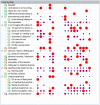The experience of meaning in circle dance
- PMID: 27366111
- PMCID: PMC4917970
- DOI: 10.1080/14427591.2016.1162191
The experience of meaning in circle dance
Abstract
Circle dance, which derives from the tradition of folk dances, is practised worldwide. This article explores the meanings participants attribute to it. In-depth interviews with 39 participants, teachers and coordinators of teacher training programmes from the circle dance network in the United Kingdom were undertaken. Applying a constructivist grounded theory approach, major categories, representing respectively the experiences of circle dance participants, teachers and coordinators, were developed. This article specifically focuses on the first major category, termed "I can't imagine life without it", which relates to the experience of 22 dancers. From an occupational perspective, the study reveals how participants realise a sense of meaning and satisfaction through engagement in circle dance and the potential contribution of this occupation to well-being.
圆圈舞派生自民间舞蹈传统,现在风靡全球。本文探讨对于参与者而言它的意义所在。对来自英国圆圈舞群体的39名学员、教师和网络教师培训计划组织者进行了深入采访。应用建构基础理论法,建立了圆圈舞学员、教师和组织者这几个大类。本文集中讨论第一大类,这一类被称为“我不能想象生活中没有它”,涉及到22个舞者的经历。从休闲角度来看,研究揭示了参与者如何通过参加跳圆圈舞而产生一种意义感和满足感, 也揭示了这种休闲活动对人们福祉的潜在作用。.
Keywords: Circle dance; leisure occupation; meaningful occupation.
Figures
References
-
- Barton A. Sacred dance at the Findhorn Foundation. In: King J., editor. The dancing circle - Volume 5: Back to our roots. Winchester, UK: Sarssen Press; 2011. pp. 53–56.
-
- Borges da Costa A. L. Dance: The heritage within everybody's hands. In: Ramos R., editor. Sacred circle dance: A proposal for education and health. São Paulo, Brazil: Triom; 1998. pp. 19–24.
-
- Borges da Costa A. L. Circle dance, occupational therapy and well-being: The need for research. British Journal of Occupational Therapy. 2012;(2):114–116. doi: 10.4276/030802212X13286281651315. - DOI
-
- Borges da Costa A. L. An investigation into circle dance as a medium to promote occupational well-being . 2014 (Unpublished doctoral dissertation). University of Bolton, UK.
-
- Canadian Association of Occupational Therapists . Enabling occupation: An occupational therapy perspective. Ottawa, Canada: CAOT Publications ACE; 1997.
LinkOut - more resources
Full Text Sources
Other Literature Sources
Miscellaneous

